Archaeology

Before Clovis? The Original Native Americans May Have Arrived 1,000 Years Before Previously Believed
Artifacts from an archaeological dig at the Cooper's Ferry site located along the Salmon River, a tributary of the larger Columbia River basin in western Idaho, suggest that the original native Americans were here 1,000 years earlier than previously thought, about 16,000 years ago.
The findings add weight to the hypothesis that initial human migration to the Americas followed a Pacific coastal route rather than through the opening of an inland ice-free corridor. The belief is that timing and position of the Cooper's Ferry site, located at the confluence of Rock Creek and the lower Salmon…

If you read the Anglo-Saxon history of England, the island was a backwater savage place populated by sacrificial druids worshiping angry spiritual gods before Rome paved the way for the arrival of modern inhabitants, but that me just be invading victors writing history.
It has been assumed northwestern European trade during the Bronze Age was primarily socially embedded, as in the exchange of gifts. It turns out people in England, before the invasions by Celts, Picts, Irish, Angles, Saxons, Romans, Vikings, and Normans, were using balance weights and scales to measure the value of…

An archaeological excavation on Mount Zion in Jerusalem has found clear evidence of the Babylonian conquest from 587/586 B.C.
The discovery is of a deposit including layers of ash, arrowheads dating from the period, as well as Iron Age potsherds, lamps and a significant piece of period jewelry - a gold and silver tassel or earring. There are also signs of a significant Iron Age structure in the associated area, but the building, beneath layers from later periods, has yet to be excavated.
The team believes that the newly-found deposit can be dated to the specific event of the conquest…

It's a mystery why humans would go to a place even colder during an ice age, and live on giant rats. Yet they did. Most people don't associate Africa with mountain living today, but Ethiopians moved to the Bale Mountains during the Palaeolithic period 45,000 years ago.
At around 4,000 meters above sea level, the Bale Mountains in southern Ethiopia are inhospitable region. There is a low level of oxygen in the air (making activist protests against astronomy by claiming sacred heritage on Mauna Kea in Hawaii even more silly, since it's higher) temperatures fluctuate sharply, and it rains a lot…

Two views of a natural endocranial cast articulated with a fragmentary skull of Australopithecus africanus, an early hominid living between 2-3 million years ago in the late Pliocene and into the early Pleistocene -- and the first pre-human to be discovered. They shared many characteristics with their older relatives the Australopithecus afarensis including a more gracile body. The casts you see here show the left maxilla, the orbital area and most of the skull base. Australopithecus africanus had a larger brain and more humanoid facial features than their older…

While traveling around the Sea of Galilee, visiting Tiberias, Magdala, Capernaum and Kursia in 725 A.D., a Bavarian bishop named Willibald passed through a place called Bethsaida where he saw a church built over the house of the Apostles Peter and Andrew, two brothers who were numbered among the first disciples of Jesus.
The New Testament said they, along with Philip, came from the village of Bethsaida, which in the first century was located on the lakeshore and today is in the Buteiha Valley Nature Reserve. It recounted that Jesus cured a blind man there.
Now archaeological excavations…

The rich and long-lasting Nordic Bronze Age was dependent throughout on incoming flows of copper and tin. The crucial turning point for the development of the Nordic Bronze Age can be pinpointed as the second phase of the Late Neolithic (LN II, c. 2000–1700 BC) precisely because the availability and use of metal increased markedly at this time. But the precise provenance of copper reaching Scandinavia in the early second millennium is still unclear and our knowledge about the driving force leading to the establishment of the Bronze Age in southern Scandinavia is fragmentary and incomplete.…

In 637, a few years after the founder of Islam, Muhammad, died, one of his military commanders completed the Arab conquest of Jerusalem, prior to that a holy city for Jews and Christians. It was over 400 years before Christians were able to take it back.
In 1099, after five weeks of siege, the city fell during their Crusade. Peter Tudebode, a contemporary chronicler, recounted that the Provencal forces led by Raymond de Saint Gille on the south side, positioned themselves somewhere on Mount Zion and proceeded to attack the wall. However, there was a ditch in front of the wall and they could…

Many First Nations sites were inhabited continually for centuries. These sites were both home, providing continuity and community and also formed a spiritual connection to the landscape. The day to day activities of each of these communities would much like our own. Babies were born, meals were served and life followed a natural cycle.
As coastal societies lived their lives they also left their mark. Sometimes through totems and carvings but almost always through discarded shells and scraps of bone from their food. These refuse heaps contain a wealth of information about how that…

A wreck with tales to tell at Naikoon in Haida Gwaii. The islands have gone by many names. To the people who call the islands home, Haida Gwaii means “island of the people,” it is a shortened version of an earlier name, Haadala Gwaii-ai, or “taken out of concealment.”
Back at the time of Nangkilslas, it was called Didakwaa Gwaii, or “shoreward country.” By any name, the islands are a place of rugged beauty, a wild spirit and hold a special place in both the natural and supernatural world. Haida oral history traces the lineage of their families back to the ocean’s origins. Spear…